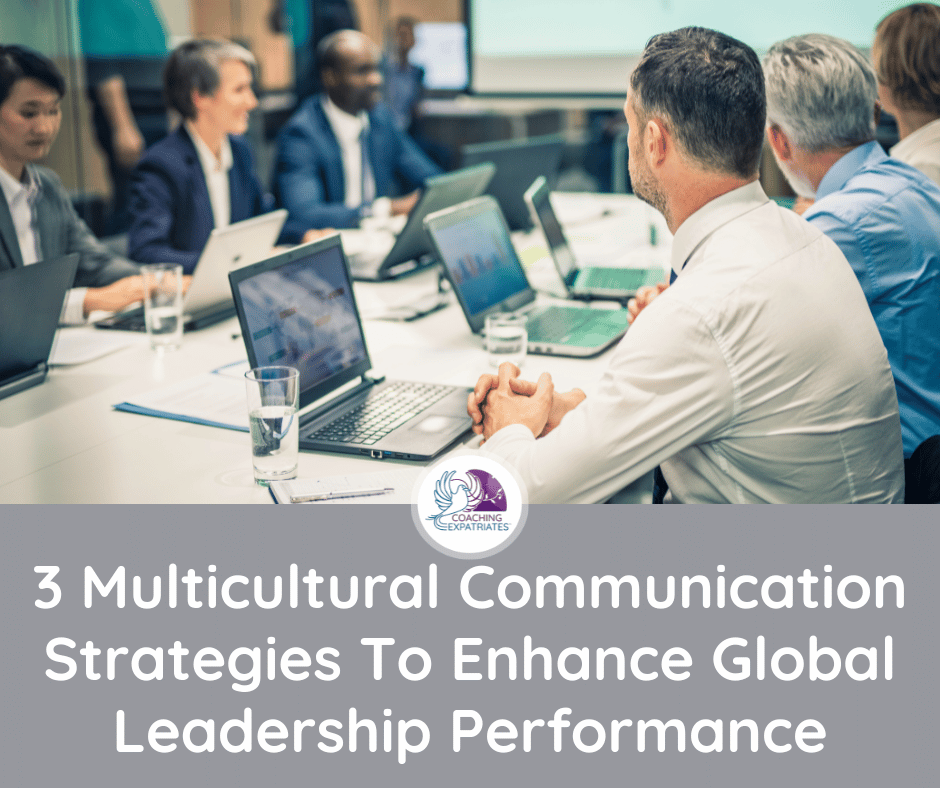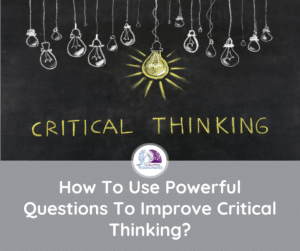In today’s globalized world, multicultural communication has become an essential skill for exceptional global leaders. It is the ability to understand and appreciate different cultures, as well as to communicate effectively with people from different backgrounds. Multicultural communication is not only a key component of successful global leadership, but it can also help foster understanding between cultures and create an environment where everyone feels respected and valued.
By understanding cultural differences and building bridges between them, multicultural communication can help create a more inclusive and tolerant world. According to the organization Migration Policy, 26% of U.S. residents were immigrants and their US-born children in 2021. This means that more than one-fourth of the U.S. has multicultural individuals who interact daily with Americans. We don’t have to be employed in a global corporation to see the need to improve cultural awareness and multicultural communication. This has become impactful for a happier lifestyle.
However, if you are employed by an international company and manage multicultural teams, learning effective strategies to improve multicultural communication and team performance is critical.
The Challenges Of Effective Multicultural Communication And How To Overcome Them
Effective communication across cultures is essential for successful collaborations between people of different cultures. However, there are many challenges when it comes to multicultural communication that can make it difficult to communicate effectively. Language barriers, cultural differences, different levels of intercultural communication skills, and misunderstandings can all lead to ineffective communication and strained relationships. Fortunately, there are steps that can be taken to overcome these challenges and ensure effective multicultural communication for business success.
Language barriers can be one of the big challenges in multicultural communication that can create many frustrations. For example, many times, U.S. citizens who are discussing a situation with someone who does not speak English and is trying to explain an issue, find that their communication becomes more difficult or ineffective because of the language barriers. Sometimes, misunderstandings can even create hostile or aggressive communication in multicultural audiences. There are ways to overcome this barrier besides, of course, basic mutual respect. One way is to use an interpreter, which is someone who can translate the conversations that usually happen between people from different countries or cultures. This will allow those from different places and cultures to understand each other without limits in their languages.
There is also a lack of understanding of cultural values and norms when it comes to cultural diversity. Cultural differences exist in every society, which could make it difficult to understand the meaning of messages. For example, different cultures place different values on time, thus making it difficult for an organization to accurately calculate how long an individual will spend on a task due to the same actions being taken differently depending on the culture.
Understanding these differences can be more difficult when communication barriers prevent effective communication between two individuals from different cultures. This is one of the reasons why learning about how to communicate in High and Low Context Cultures can become a valuable skill to learn in global leadership to overcome this challenge. It’s like learning communication styles on steroids! It’s a practical skill that helps us learn how to flex and accommodate preferences. Another critical way to overcome cultural barriers is by learning the Culture Map, an ingenious way to map 2 or more cultures and learn how to flex and adapt around them.
By understanding the common challenges of intercultural communication, utilizing effective strategies for communicating across cultures, and learning how to bridge language barriers, organizations can ensure they are able to communicate effectively with people from different backgrounds.
3 Effective Strategies For Global Leaders To Enhance Their Cross-Cultural Communication
As businesses become increasingly global, it is important for leaders to have the skills to navigate different cultures and build relationships with people from different backgrounds. Having cross-cultural competence is essential for global leaders in order to effectively lead their teams and organizations. Let’s discuss four effective strategies that can help global leaders enhance their multicultural competence and communication skills. These strategies include understanding cultural differences, developing cultural awareness, building relationships across cultures, and adapting to new cultures. By implementing these strategies, global leaders can better understand the needs of their multicultural teams and foster successful collaborations among them.
Strategy #1: Understanding Cultural Differences
The ability to understand cultural differences is essential for a successful global business. A lack of understanding can lead to costly mistakes, miscommunications, and a lack of trust between parties. To avoid this and effectively build trust, it is important to use tools such as the Culture Map and the Lewis Model to understand how different cultures interact.
The Culture Map
The Culture Map is a tool developed by Erin Meyer that maps out eight key communication preferences across different cultures. These include how people approach communication topics, how they express themselves, how direct they are, how much debate is tolerated, and how status is shown. Understanding the differences between these preferences in a culture you are interacting with, and your own culture, can improve your approach to communicating with them.
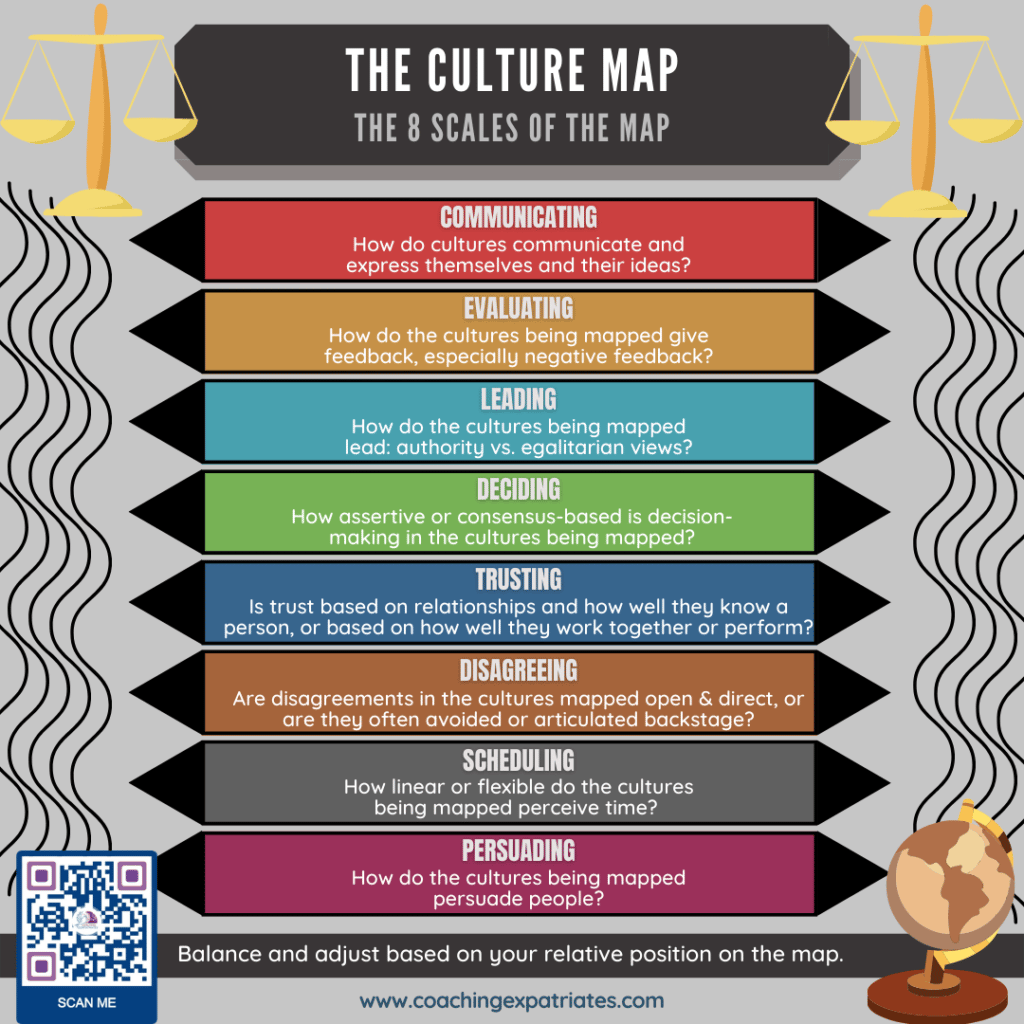
The Lewis Model
The Lewis Model is another interesting tool and concept used in cultural communication, developed by Richard Lewis in 1990, and documented in his work When Cultures Collide. This model categorizes cultures by dividing cultural behaviors into 3 clear categories, based on how they show up. He labeled these behavioral categories Linear-active, Multi-active, and Reactive. By understanding how certain cultures behave and how your own culture behaves, you can start to gain cultural awareness of the gaps and what to do to adjust.
High & Low Context Cultures
Lastly, another famous concept that helps individuals harness cultural differences comes from Edward T. Hall and his concepts on how to communicate with high and low context cultures. This model, unlike the Lewis model that plots cultures in 3 different dimensions, in Hall’s model, every culture is put in one single dimension of cultural context. Cultures that need more context to operate are classified as high-context cultures, while cultures that need less context are called low-context cultures. High-context cultures draw significance from symbols and cues, are relationship-oriented, and have a non-linear sense of time, while low-context cultures are direct when providing messages, are task-oriented, and have a linear sense of time.
All these tools and concepts are awesome to learn, and they all basically tell similar things, that’s why they can stack the perfect knowledge for greater cultural awareness and closing gaps in cultural differences.
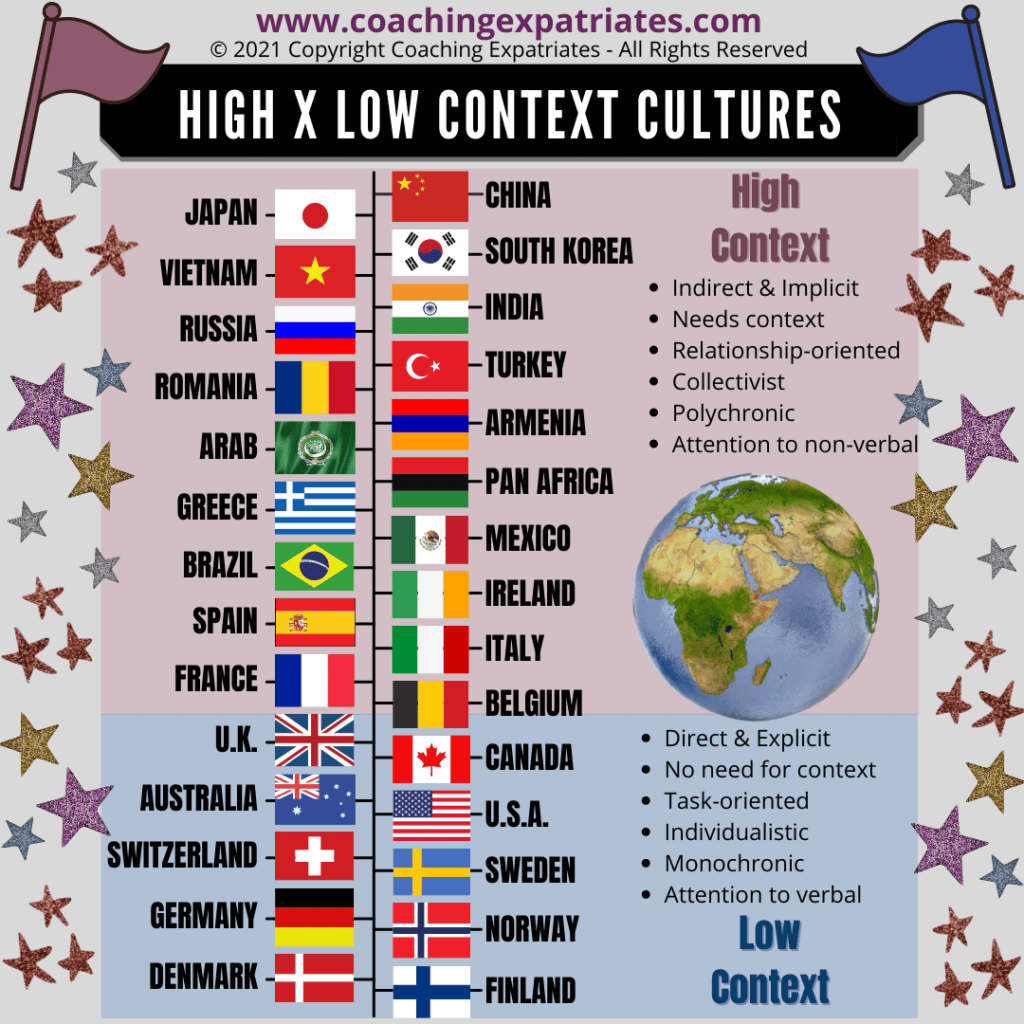
Strategy #2: Developing Cultural Awareness
Developing cultural awareness is becoming an increasingly important skill in the workplace. It is essential for employees to be able to understand and appreciate different cultures in order to build successful relationships with clients and colleagues.
Some of the strategies for developing intercultural competence include improving intercultural communication skills in different cultural contexts, gaining knowledge about different cultures, and increasing self-awareness.
Improving Intercultural Communication Skills In Different Cultural Contexts
Communication is a complex and nuanced process and can be especially challenging when working in different cultural contexts. To improve communication skills in these contexts, it is important to first do research on the cultural norms and expectations of the people you are communicating with. Additionally, it is beneficial to become aware of your own cultural biases and how they may influence your communication with people from other cultures. Finally, it is important to be patient, open-minded, and respectful when interacting with people from different cultures, as well as actively listening to what they have to say.
Gaining Cultural Self-Awareness
In order to increase cultural self-awareness, it is important to be willing to learn and open to new perspectives. This can include learning about different cultures and traditions as well as exploring global perspectives. It is also beneficial to be willing to engage in meaningful conversations with people of different cultural backgrounds and learn from them. Additionally, actively participating in activities such as attending cultural events, joining a cultural club, or even traveling to a different country can help build cultural self-awareness.
Improving Cultural Competence
Gaining knowledge about different cultures is a great way to expand your worldview and improve cultural competence. One of the best ways to do this is to travel and immerse yourself in a culture that is different from your own. Through travel, you can learn about the customs and traditions of a culture, how they dress, how they communicate, and more. Additionally, learning about the history of a culture can give you insight into why certain beliefs and practices are held and the influences that have shaped them. Also, by talking with people from different cultures in an immersive situation like this can give you an even deeper understanding of their values, beliefs, and traditions. If you are interested in improving your cultural competence, we explore 8 different ways to improve cultural competence in this post.
The Difference Between Cultural Competence And Cultural Awareness
Cultural awareness is when you notice other people eat their meals using Hashi 箸 (the chopsticks) when you are using a different type of cuttery, but both of you achieve similar results, which is being able to eat the food without directly touching it. Cultural competence is like when you start using Hashi yourself, know why and when to use it, and become better at manipulating and knowing the its use in terms of norms and etiquette according to those who use it. Although this is a very simplistic analogy, you can expand this concept to all aspects of a culture. Before you can gain competence, you first must become aware.
Strategy #3: Building Relationships Across Cultures
Building relationships across cultures is one of the most important strategies to ensure a successful global business. It helps to foster understanding and respect, which leads to better collaboration and innovation.
It is important to remember that different cultures have different ways of communicating and interacting with each other. Pen friends, multicultural activities, exchange programs, international courses, and other methods of building cross-cultural relationships can help bridge the gap between cultures. This can be done through learning about each other’s customs, values, beliefs, and language. Through this process, people can gain an appreciation for different perspectives and be more open-minded when it comes to dealing with cultural differences.
Pen Friends
Developing a relationship with a penfriend is a great way to learn about different cultures and make connections with people from around the world. It helps you open your mind and create cultural awareness and better multicultural communication in ways that no communication training will be able to grant.
To build a strong relationship with your penfriend, make sure to write often and share details about your life. Ask questions about your penfriend’s interests, hobbies, and culture, and share stories about yours. Offer support and advice if your pen pal is going through a difficult time, and take the time to get to know them better by having conversations about topics that interest both of you. Don’t forget to send pictures of yourself or things from your hometown so that your penfriend can relate to you and your world.
To find a new penfriend, you can join a Facebook group, join a club like Global Penfriends, or hire penfriend services, like services provided by International Pen Friends®.
If you work for a big company that houses a global workforce, you can suggest creating a penfriend program inside your company. This will help not only with cultural competence, but also people from different departments learn from each other.
Multicultural Education And Activities
Multicultural education and activities are events that celebrate and educate about the diversity of cultures. These activities can range from ethnic festivals and parades to educational activities such as multicultural books, stories, cooking, and art projects. Multicultural education and activities allow people to learn about different cultures and customs and appreciate each other’s differences. These activities can be done in a classroom, family setting, or even in a larger community setting.
They are great for promoting cultural awareness and understanding of different cultures. With these activities, we can learn to appreciate and understand different cultures, while also celebrating various cultures. For example, my local town’s library recently promoted a Lunar New Year celebration, where not only the Chinese community was present, but people all over town. Participating in these kinds of events and learning more about a new culture for you is fun.
You can hold multicultural activities in your company too. For example, you can host a monthly activity where you invite an employee from a different part of the world to tell a bit about their country and costumes, and do something fun based on that costume. For example, if you come from Japan, you can teach origami to the participants. If you come from a country where dance is a key cultural aspect and you know how to dance, you can teach some moves to the participants. Or, if that is scary, you can bring people from your community to teach and share different things. All this can be done in 1 or 2 hours event, during lunch, for example.
International Courses
Befriending other cultures through international courses is an excellent way to learn about different cultures, customs, and people. Not only does this provide corporate students with an opportunity to gain a greater understanding of the world around them, but it also provides students with the chance to experience another culture firsthand.
Through these courses, corporate students are exposed to different languages, customs, and lifestyles from around the world. These courses open up a whole new world of possibilities that can be explored and experienced by anyone who takes part in them. Whether it be in the classroom, at a conference promoted by the company, on a trip abroad, or even via zoom, international courses can provide students with an invaluable learning opportunity for better communication, cultural competence, and intercultural communication.
One good example is our international global executive leadership program called The Global Leadership Pillars™, where we gather global executives worldwide to learn key leadership skills. Different leaders interact with each other and learn a new way to think, relate and strategize as a global leaders.
Exchange Programs
Exchange programs are an excellent way to build meaningful relationships between people of different cultures and improve cross-cultural communication. They provide the opportunity for individuals to experience different cultures firsthand by living, studying, and working in another country.
Living as an Expat can help foster meaningful and lasting friendships between people from different backgrounds. Exchange programs often involve language courses and cultural activities, allowing participants to better understand the people and culture of the host country. Furthermore, participating in an exchange program can help individuals better appreciate diversity and build empathy for others from different cultures.
My global leadership journey started when I was 11 years old, and I convinced my father to allow me to go to England for an exchange program through a student travel bureau. It changed my view of the world, and how to interact with different people, but it also allowed me to make tons of friends from around the world. If ‘immersive’ is part of your game, this is an excellent strategy for improving multicultural communication.
One way global companies achieve this is by providing international short term assignments to their employees. These assignments can be in their normal field of expertise, or in another completely different department. It all depends on how the company wants to structure this kind of development programs for its employees.
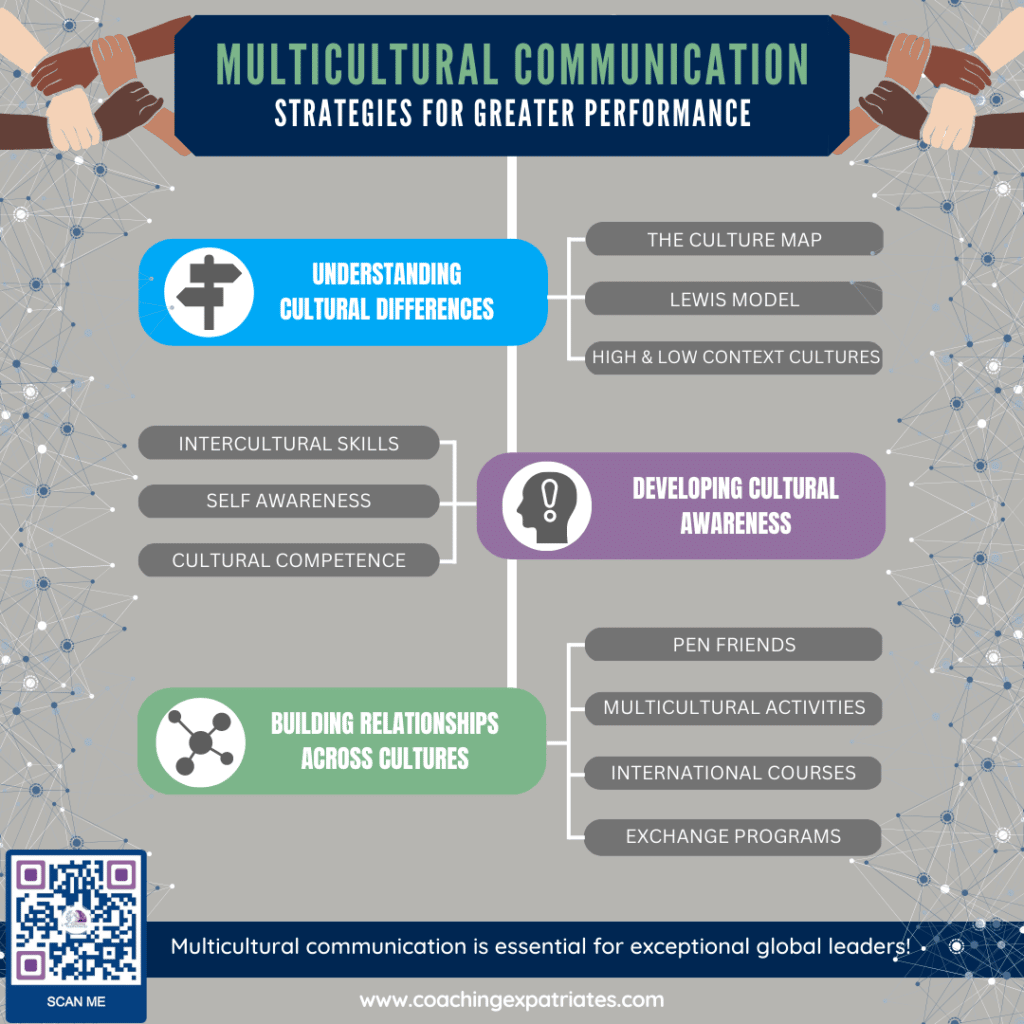
How Technology Can Help Improve Multicultural Communication In The Workplace
Technology can vastly help improve our multicultural communication skills by providing tools and solutions for global leadership teams. By leveraging e-learning platforms, virtual meetings, global networking tools, worldwide instant messaging, and other technology solutions, organizations can close gaps in communication, create a better understanding of different cultures, and facilitate more effective communication.
Technology For Learning
Technology can also be used to enhance cross-cultural understanding and improve intercultural communication skills through online training programs and simulations that help employees learn about different cultures from around the world. Additionally, organizations can leverage technology to provide access to language translation services or bring language services providers virtually, which can help bridge cultural gaps in communication.
Technology For Meeting
Technology tools for virtual meetings can help with multicultural communication by providing an array of features. Video conferencing platforms such as Zoom, Webex, Skype, and Google Hangouts provide the ability to host meetings with participants located around the world, allowing the conversations to be conducted in multiple languages. Text-based tools such as chat rooms and instant messaging capabilities can also help facilitate communication between cultures during meetings. Additionally, features such as screen sharing and whiteboards can help to effectively display information and visuals, enabling all participants to understand the message regardless of language. By utilizing such tools, virtual meetings can be a great way to bridge different requirements that the various cultures have.
Technology For Communicating
Instant communication tools can be an invaluable asset for large global corporations seeking to communicate effectively with dispersed teams, customers, and partners. Instant communication tools such as Skype and Slack allow businesses to connect with a wide variety of stakeholders regardless of geographic location. With these tools, businesses can quickly share documents, have video and audio conferences, and collaborate in real time, while also being able to manage different time-zones. Additionally, instant communication tools are cost-effective and easy to use, making them a great choice for global corporations looking to streamline their communication processes.
By utilizing the right technology solutions, organizations can ensure that their workforce is well-equipped with the skills and tools needed to communicate effectively across cultural boundaries. This will enable them to maximize their potential and capitalize on opportunities presented by globalization.
Final Remarks
In a nutshell, multicultural communication in global leadership is a complex but rewarding endeavor. It requires the ability to understand and appreciate cultural differences, the courage to challenge stereotypes, and the willingness to build bridges between people of different backgrounds. As the world becomes increasingly interconnected, it is important for leaders to develop the skills necessary to communicate effectively across cultures. With the right set of skills, leaders can successfully foster positive and productive collaboration between people of different backgrounds, resulting in innovative solutions and successful outcomes.
If you are looking for a development expert to help you implement some of these strategies, you can hire me as your executive and development coach. Have a Free Strategy Call with me. We will go over your goals and devise together the top priority initiatives and their budgets.
If you are interested in developing specific global leadership skills and multicultural communication, check out our online Global Executive Leadership Program. We go over all 4 of The Global Leadership Pillars® during the 9 online modules specially meant for global leadership.
If you enjoyed this post, consider subscribing to our newsletter using the form below. We focus on providing good content to global leaders and executives who want to make impactful business decisions and be more inclusive and influential. We know your inbox is sacred, so we email just once per week, and we never sell your information. Trust is the basis of Global Leadership, and we fully honor it.

